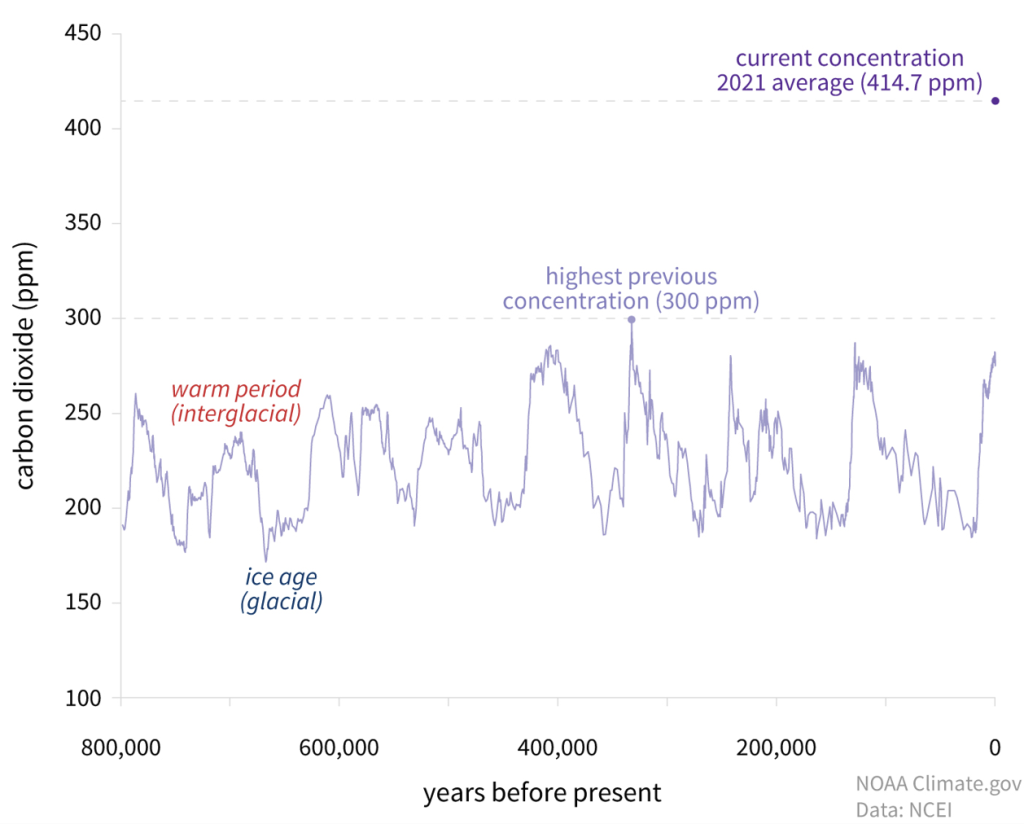Carbon Removal Explained: All You Need to Know
Impactful Ninja is reader-supported. When you buy through links on our site, we may earn an affiliate commission.
Learn more
Learn more
.
Hey fellow impactful ninja ? You may have noticed that Impactful Ninja is all about providing helpful information to make a positive impact on the world and society. And that we love to link back to where we found all the information for each of our posts. Most of these links are informational-based for you to check out their primary sources with one click. But some of these links are so-called "affiliate links" to products that we recommend. First and foremost, because we believe that they add value to you. For example, when we wrote a post about the environmental impact of long showers, we came across an EPA recommendation to use WaterSense showerheads. So we linked to where you can find them. Or, for many of our posts, we also link to our favorite books on that topic so that you can get a much more holistic overview than one single blog post could provide. And when there is an affiliate program for these products, we sign up for it. For example, as Amazon Associates, we earn from qualifying purchases. First, and most importantly, we still only recommend products that we believe add value for you. When you buy something through one of our affiliate links, we may earn a small commission - but at no additional costs to you. And when you buy something through a link that is not an affiliate link, we won’t receive any commission but we’ll still be happy to have helped you. When we find products that we believe add value to you and the seller has an affiliate program, we sign up for it. When you buy something through one of our affiliate links, we may earn a small commission (at no extra costs to you). And at this point in time, all money is reinvested in sharing the most helpful content with you. This includes all operating costs for running this site and the content creation itself. You may have noticed by the way Impactful Ninja is operated that money is not the driving factor behind it. It is a passion project of mine and I love to share helpful information with you to make a positive impact on the world and society. However, it's a project in that I invest a lot of time and also quite some money. Eventually, my dream is to one day turn this passion project into my full-time job and provide even more helpful information. But that's still a long time to go. Stay impactful,Affiliate Disclosure
Why do we add these product links?
What do these affiliate links mean for you?
What do these affiliate links mean for us?
What does this mean for me personally?
![]()
More than 80 countries have committed to reaching net-zero carbon emissions by 2050. However, to meet this target, removing carbon from our atmosphere is crucial. So, we had to ask: What is carbon removal really, and could it help us mitigate climate change?
Carbon removal eliminates carbon emissions after they have entered our atmosphere. It mitigates climate change, improves air quality, and protects ecosystems. But it does not address the core issue of reducing overall carbon emissions and is limited by cost and storage capacity.
Keep reading to find out all about what carbon removal is, the impact you can have with it both individually and globally, its benefits and drawbacks, and why it may not be the most effective way to mitigate climate change.
The Big Picture of Carbon Removal
Carbon removal is the process of eliminating carbon from the atmosphere. It is also referred to as negative emissions or carbon drawdown.
“Carbon Removal: the process of removing CO2 from the atmosphere”
The Intergovernmental Panel on Climate Change
Carbon removal can be split into 2 categories, technological and natural carbon removal.
- Technological removal: This involves specialized technology which extracts carbon from the atmosphere. A prominent example of this is Climeworks, whose specialized ‘direct air capture’ machines take carbon dioxide (CO2) from the air and turn it to stone via specialized processes.
- Natural removal (carbon sequestration): Carbon is stored naturally in vegetation (forests), soils, and oceans. Forests absorb 2.6 billion tons of CO2 every year, the soil absorbs approximately 25% of all carbon emissions, and phytoplankton in our oceans absorb approximately 25% of all carbon emissions.
Overall, different carbon removal processes can include:
- Afforestation/ reforestation: Planting new forests
- Soil carbon sequestration: Storing captured carbon in the soil
- Biochar: Creating charcoal and burying it or plowing it into fields
- Bioenergy: Capturing and sequestering carbon from biofuels and bioenergy plants
- Enhanced mineralization: Crushed rocks are spread over the land to absorb carbon
- Direct Air Capture (DAC): Machines suck carbon out of the atmosphere and store it in geological formations underground
- Ocean-based methods: Ocean alkalization/fertilization, artificial upwelling/dwelling
To date, 19 countries have explicitly stated the amount of carbon removal they intend to use to meet their mid-century climate goals. For example:
- The US plans to remove 1 billion tons of carbon by 2050.
- Spain intends to meet 10% of its overall target by 2050 via natural carbon removal approaches.
- Nepal plans to remove 5.7 million metric tons of carbon via land-based approaches by 2050.
- And Slovenia plans to reduce carbon emissions by 80-90% from their 2005 baseline by 2050, with the remaining emissions to be compensated for with carbon removal practices.
A leader in today’s carbon removal industry is Climeworks, a direct air capture company based in Zurich, Switzerland. Their specialized machines take CO2 from the air, mix it with water, and pump it deep underground. Through the process of natural mineralization, the captured CO2 is turned into stone. For every 100 tons of CO2 captured from the air, 90 tons are permanently removed, and only up to 10 tons are re-emitted by the DAC machines.
| What carbon removal is | Carbon removal is the process of eliminating carbon from the atmosphere. |
| How carbon removal works | Carbon removal represents indirect emission reductions. Carbon is eliminated after the emissions have already entered our atmosphere. |
| The impact of carbon removal on your own emissions | Carbon removal does not directly reduce your carbon footprint. |
| The impact of carbon removal on global emissions | Carbon removal mitigates the problem, but it does not work at the core issue of reducing overall carbon emissions. |
| The overall effectiveness of carbon removal in reducing carbon emissions | Cost and storage capacity limits affect carbon removal effectiveness on a global scale. |
| The main benefits of carbon removal | Carbon removal aids in climate change mitigation, improves air quality, and protects ecosystems. |
| The main drawbacks of carbon removal | Wide-ranging costs and carbon sink limitations. |
How Does Carbon Removal Work
Carbon removal refers to the elimination of carbon via technological or natural processes. It is one way to mitigate the adverse effects of carbon emissions that occur once they enter our atmosphere.
How Does Carbon Removal Reduce Carbon Emissions
The goal of carbon removal is to reduce carbon emissions and mitigate climate change.
- Carbon removal represents indirect emission reductions. It is the removal of already emitted carbon from the atmosphere.
Carbon removal still permits the combustion of fossil fuels at current rates, it just eliminates the carbon after it has entered our atmosphere. The carbon can then be stored permanently in land or ocean-based reservoirs via technological or natural processes.
What Impact Does Carbon Removal Have on Your Own Carbon Emissions
One of the best ways we can aid in the fight against global climate change is to reduce our carbon footprint. And to do this we first have to reduce our carbon emissions.
- Carbon removal does not directly reduce your carbon footprint.
Carbon removal does not directly reduce your own carbon emissions. It is an indirect method of emission reduction, and knowing there is an option to essentially erase our emissions after we cause them negates any incentive of reducing emissions of our own accord.
What Impact Does Carbon Removal Have on Global Carbon Emissions
Every year we pump over 36 billion tons of CO2 into the atmosphere, fueling climate change. This causes temperature and sea-level rise, melting of sea ice, changing precipitation patterns, and ocean acidification. Carbon removal aims to reduce global emissions and mitigate these negative environmental effects.
- Carbon removal mitigates the problem, but it does not work at the core issue of reducing overall CO2 emissions.
Carbon removal does not have a significant impact on global carbon emissions. To contribute substantially to the fight against climate change, global carbon removal capacity would need to reach 10 gigatons (Gt) of carbon by 2050 and 20 Gt of carbon for each year from 2050 to 2100. Currently, carbon removal processes contribute negligibly to this amount. Thus, there remains a substantial gap between what we currently have and what is needed to reduce our emissions to the Paris Climate Agreement target levels for carbon removal.
How Effective Is Carbon Removal in Reducing Carbon Emissions
Carbon removal can be effective at reducing carbon emissions under certain conditions.
- Carbon removal effectiveness is limited by cost and storage capacity limits.
The main factors affecting carbon removal effectiveness are the cost and storage capacity limits, which depend on the removal method. In general, technological methods of carbon removal are more expensive and have a greater carbon storage capacity when compared to natural methods.
For example, planting trees is one of the cheapest and most natural ways to remove carbon from the atmosphere, but storage capacity is limited by available land and can be negatively impacted by deforestation. On the other hand, direct air capture is more expensive than planting trees ($250-$650 per 1,000kg compared to $50 per 1,000kg), but the storage capacity is vastly greater.
Carbon removal is also a reactive, rather than proactive, way of dealing with emissions. In this manner, we can continue to use fossil fuels at an accelerated rate. Removal technologies are expensive to implement, and there will be little economic incentive to use them until the cost of emitting carbon rises enough to prompt behavioral changes.
What Are the Main Benefits and Drawbacks of Carbon Removal
As with anything, carbon removal comes with benefits and drawbacks that must be understood before we decide to implement this technology on a large scale.
What Are the Main Benefits of Carbon Removal
Carbon removal comes with environmental benefits in addition to limiting global carbon emissions resulting from fossil fuels (i.e., coal, oil, and natural gas).
- Aids in climate change mitigation: Carbon removal aims to eliminate carbon emissions from our atmosphere. Levels of carbon in our atmosphere that cause climate change have increased as a result of human emissions since the beginning of the Industrial Revolution in 1750. The global average concentration of carbon dioxide in the atmosphere today registers at over 400 parts per million. Carbon removal can help prevent these levels from increasing even more.

- Improves Air Quality: Degradation of air quality as a result of carbon emissions is a serious issue. In 2009, the US government declared CO2, CH4, N2O, hydrofluorocarbons (HFCs), perfluorocarbons (PFCs), and sulfur hexafluoride (SF6) threats to the public health and welfare of current and future generations. Removing carbon emissions from the atmosphere would lead to improved public health in terms of asthma, respiratory allergies, airway diseases, and lung cancer.
- Protects ecosystems: Removing carbon from the atmosphere promotes healthy ecosystems, which have been linked with cleaner air, water, and food. Protecting forest habitats increases carbon sequestration and defends against erosion. Protecting agricultural land ensures a robust, secure, and prosperous food system. Protecting aquatic ecosystems ensures a readily available supply of fresh water. Lastly, protecting biodiversity protects human health because many plants and animals are used in modern medicines.
Carbon removal can mitigate the effects of climate change, which has a positive cascade effect on public health and plant and animal diversity. In addition, it boosts the global economy and leads to innovative, more environmentally-friendly solutions in years to come.
What Are the Main Drawbacks of Carbon Removal
The main drawback to carbon removal methods is the high cost of development and implementation. Costs vary widely depending on the method utilized:
- Afforestation/reforestation: $50-$2,000 per hectare
- Soil carbon sequestration: $0-$100 per ton
- Biochar: $100 per 1.1 ton
- Bioenergy: $20-$200 per ton
- Enhanced mineralization: $50-$200 per ton
- Direct Air Capture (DAC): $250-$650 per 1.1 ton
- Ocean-based Methods: $70-$160 per ton
Cutting the cost of carbon removal will be necessary to make it an affordable and dependable method of global carbon reduction.
And the main drawback to natural carbon removal methods involves carbon sink limitations. There simply aren’t enough carbon sinks (i.e. forests, oceans, soil) to contain every ton of carbon that we remove, and once those sinks fill up, we won’t be able to sequester any more carbon. And the more carbon we add to these sinks, the faster we degrade them and render them unusable.
Why Is Carbon Removal Important to Fight Climate Change
As outlined in the 2015 Paris Climate Agreement, we must cut current greenhouse gas (GHG) emissions by 50% by 2030 and reach net zero by 2050. Carbon removal is important to meet these targets because it eliminates carbon, that when emitted, can remain in our atmosphere for tens of thousands of years.
However, carbon removal should not be used as a panacea for climate change. Relying on it solely is impractical because it does not prevent further emission of carbon, it only eliminates some of what we have already emitted.
In the long term, direct methods of carbon footprint reduction are much more effective. Reducing your household, travel, and lifestyle carbon footprint can go a long way in the fight against climate change!
What are Better Alternatives to Carbon Removal
If used correctly, carbon removal can provide environmental, economic, and social benefits beyond reducing carbon emissions. It has the potential to instigate meaningful environmental change and begin to reverse some of the effects of climate change.
However, we can’t let this method be a guilt-free way to reduce carbon emissions. Carbon removal must be used in conjunction with direct carbon reduction measures until the industry has time to invest, develop, and refine more sustainable innovations.
These reduction measures don’t have to involve drastic changes either. Actions that may seem small can have a big impact because those small changes add up! You can reduce your carbon footprint in three main areas of your life: household, travel, and lifestyle.
Reduce your household carbon footprint:
- Wash with cold water: Washing clothes in cold water could reduce carbon emissions by up to 11 million tons. Approximately 90% of the energy is used to heat the water, so switching to cold saves also saves energy.
- Replace incandescent bulbs with fluorescent bulbs: Fluorescent bulbs use 75% less energy than incandescent ones, saving energy and thus reducing electricity demand and GHG emissions.
Reduce your travel carbon footprint:
- Fly less: Aviation accounts for around 1.9% of global carbon emissions and 2.5% of CO2. Air crafts run on jet gasoline, which is converted to CO2 when burned.
- Walk or bike when possible: The most efficient ways of traveling are walking, bicycling, or taking the train. Using a bike instead of a car can reduce carbon emissions by 75%. These forms of transportation also provide lower levels of air pollution.
Reduce your lifestyle carbon footprint:
- Switch to renewable energy sources: The six most common types of renewable energy are solar, wind, hydro, tidal, geothermal, and biomass energy. They are a substitute for fossil fuels that can reduce the effects of global warming by limiting global carbon emissions and other pollutants.
- Recycle: Recycling uses less energy and deposits less waste in landfills. Less manufacturing and transportation energy costs means fewer carbon emissions generated. Less waste in landfills means less CH4 is generated.
- Switch from single-use to sustainable products: Reusing products avoids resource extraction, reduces energy use, reduces waste generation, and can prevent littering.
- Eat less meat and dairy: Meat and dairy account for 14.5% of global GHG emissions, with beef and lamb being the most carbon-intensive. Globally, we consume much more meat than is considered sustainable, and switching to a vegan or vegetarian diet could reduce emissions.
- Take shorter showers: Approximately 1.2 trillion gallons of water are used each year in the United States just for showering purposes, and showering takes up about 17% of residential water usage. The amount of water consumed and the energy cost of that consumption are directly related. The less water we use the less energy we use. And the less energy we use, the less of a negative impact we have on the environment.
Because carbon removal is an indirect way and not a direct way of reducing emissions, it alone will not be enough to reduce global carbon emissions significantly. Direct measures of emission reductions, such as reducing individual energy use and consumption, are better alternatives to carbon removal.
Final Thoughts
Carbon removal is the process of eliminating carbon from the atmosphere. It does not work at the core issue of reducing global carbon emissions because it is a reactive way of dealing with emissions. It also faces financial barriers due to its high cost of research, development, and implementation. However, when implemented properly it can aid in climate change mitigation, improve air quality, and protect our ecosystems.
Carbon removal is a good place to start if you want to get into the carbon-emission reduction game, but to be effective in the long term, we must not rely on it solely. Cutting emissions from the source is the best way to reduce our carbon footprint and provide the highest environmental benefits.
Stay impactful,

Sources
- World Resources Institute: How are Countries Counting on Carbon Removal to Meet Climate Goals?
- myclimate: What does “net zero emissions” mean?
- American University: What is Carbon Removal?
- South Pole: Carbon Offsets Explained
- ClientEarth: What is a carbon sink?
- Columbia Climate School: Can Soil Help Combat Climate Change?
- World Economic Forum: The oceans are absorbing more carbon than previously thought
- Climeworks: Homepage
- Climeworks: Direct air capture – a technology to remove CO₂
- Climeworks: Reverse climate change by removing CO2 from the air
- Our World in Data: CO2 emissions
- National Wildlife Federation: Climate Change
- World Resources Institute: Carbon Removal
- US Department of Energy – Office of Fossil Energy and Carbon Management: Carbon Dioxide Removal FAQs
- World Economic Forum: Carbon removal – the Three Conditions to Make it Successful
- World Resources Institute: Direct Air Capture – 6 Things to Know
- CNBC: Carbon capture technology has been around for decades — here’s why it hasn’t taken off
- Impactful Ninja: What Is the Carbon Footprint of Coal Energy? A Life-Cycle Assessment
- Impactful Ninja: What Is the Carbon Footprint of Oil Energy? A Life-Cycle Assessment
- Impactful Ninja: What Is the Carbon Footprint of Natural Gas? A Life-Cycle Assessment
- National Oceanic and Atmospheric Administration: Climate Change – Atmospheric Carbon Dioxide
- National Oceanic and Atmospheric Administration: Carbon Dioxide Over 800,000 Years
- United States Environmental Protection Agency: Endangerment and Cause or Contribute Findings for Greenhouse Gasses under the Section 202(a) of the Clean Air Act
- National Institute of Environmental Health Sciences: Asthma, Respiratory Allergies and Airway Diseases
- National Institute of Environmental Health Sciences: Cancer
- Natural Resources Defense Council: Carbon Offsets 101
- Carbon Brief: Climate change will hit ‘endemic’ plants and animals the hardest, study warns
- One Green Planet: How Saving Wildlife Benefits Humans – In Ways We Really Need
- World Health Organization: Biodiversity and Health
- United Nations Framework Convention on Climate Change: Paris Climate Agreement
- The Economist: Afforestation and Reforestation – Restoring trees to ecologically suitable landscapes
- American University: Fact Sheet – What is Soil Carbon Sequestration?
- Greenbiz: Why Microsoft and Shopify are betting on biochar
- American University: Fact Sheet – What is BECCS?
- American University: Fact Sheet – What is Enhanced Mineralization?
- American University: Fact Sheet – What is Ocean Alkalinization?
- American University: Fact Sheet – Carbon Removal
- The Ocean Foundation: Reduce Your Carbon Footprint
- Cold Water Saves: Washing Laundry In Cold Water Protects A Lot More Than Just Our Clothing.
- Energy Information Administration: Renewable Energy Explained
- Energy Star: Compact Fluorescent Light Bulbs (CFLs) and Mercury
- Our World in Data: Where in the world do people have the highest CO2 emissions from flying?
- Our World in Data: Which form of transport has the smallest carbon footprint?
- Zero Waste Europe: Reusable vs Single Use Packaging
- Carbonbrief: Interactive – What is the climate impact of eating meat and dairy?
- Stop Waste: Recycling and Climate Protection
- Impactful Ninja: Is Taking Long Showers Bad for the Environment?
- United States Environmental Protection Agency: Showerheads
- Impactful Ninja: 4 Main Reasons Why Reducing Your Carbon Footprint is Important




